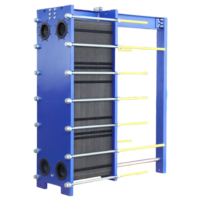Choosing the Right Construction Method for Your PHE
When selecting a development method for plate heat exchangers (PHEs), engineers must consider components such as working conditions, fluid properties, support necessities, and budget constraints. Choosing the Right Construction Method for Your PHE, Two common development methods for PHEs are brazed plates and gasketed plates, each advertising particular advantages and considerations:
Brazed Plate Heat Exchangers:
- Construction: Brazed plate heat exchangers comprise of corrugated plates that are brazed together at their contact points employing a high-temperature brazing handle. This makes a compact and inflexible heat exchanger unit with no external gaskets.
Advantages:
- Compact Design: Brazed plate heat exchangers have a compact impression due to the nonappearance of external gaskets, making them perfect for space-constrained installations.
- High Thermal Efficiency: Brazed development guarantees excellent heat exchange efficiency, as the brazing handle makes a solid metal-to-metal bond between plates, minimizing thermal resistance.
- Resistant to High Pressures and Temperatures: Brazed plate heat exchangers are reasonable for high-pressure and high-temperature applications due to their robust construction.
- Low Maintenance: With no external gaskets, brazed plate heat exchangers require minimal maintenance and are less prone to leakage or gasket disappointment.
Considerations:
- Limited Service ability: Brazed plate heat exchangers cannot be disassembled for cleaning or plate substitution, making them less appropriate for applications with fouling or scaling tendencies.
- Higher Initial Cost: Brazed plate heat exchangers regularly have a higher beginning cost compared to gasketed plate heat exchangers, which may affect project budgets.
Gasketed Plate Heat Exchangers:
- Construction: Gasketed plate heat exchangers highlight folded plates gathered together with gaskets at their edge, shaping flow channels for the hot and cold liquids.
Advantages:
- Modular Design: Gasketed plate heat exchangers have a modular plan, permitting for simple disassembly and reassembly for cleaning, maintenance, or plate replacement.
- Versatility: Gasketed development offers flexibility in plate materials, gasket materials, and plate configurations, making them appropriate for a wide extend of applications and working conditions.
- Tolerant to Fluid Contaminants: Gasketed plate heat exchangers can handle liquids containing solids, fibers, or particulates without influencing fixing integrity, making them appropriate for dirty fluid applications.
- Lower Initial Cost: Gasketed plate heat exchangers generally have a lower starting cost compared to brazed plate heat exchangers, making them more cost-effective for certain applications.
Considerations:
- Potential for Gasket Failure: Outside gaskets are helpless to wear, degradation, or chemical attack, which can lead to spillage or misfortune of sealing integrity.
- Increased Maintenance Requirements: Gasketed plate heat exchangers may require occasional support to supplant worn or harmed gaskets, especially in applications with forceful liquids or tall temperatures.
- Larger Footprint: The nearness of outside gaskets includes to the in general estimate and weight of gasketed plate heat exchangers, which may be a thought for installations with limited space.
In summary, the choice between brazed and gasketed plate heat exchangers depends on the particular requirements of the application, counting space limitations, working conditions, maintenance preferences, and budget contemplations. Whereas brazed plate heat exchangers offer points of interest such as compact plan and high thermal efficiency, gasketed plate heat exchangers give versatility, serviceability, and cost-effectiveness for a broader range of applications.


